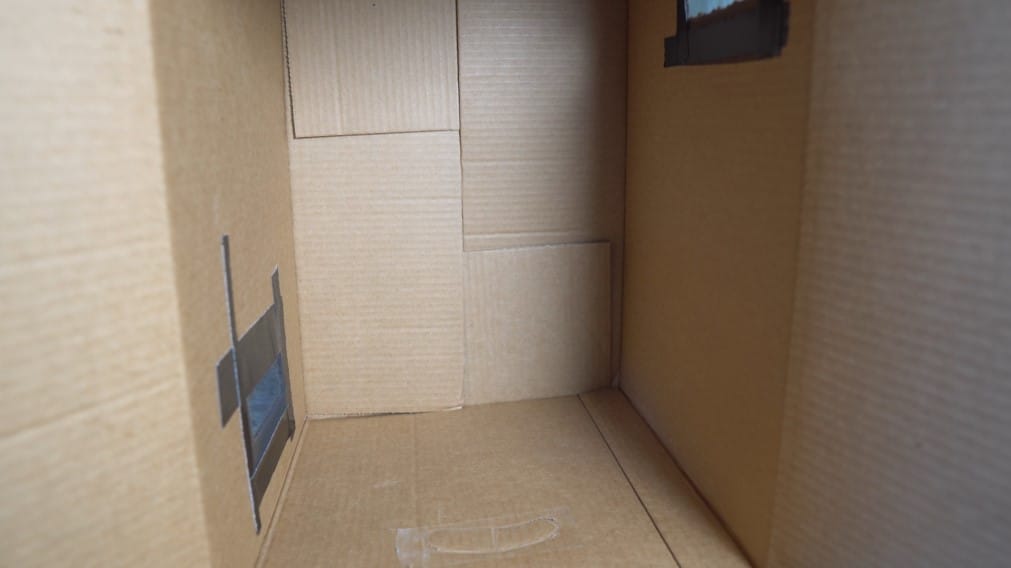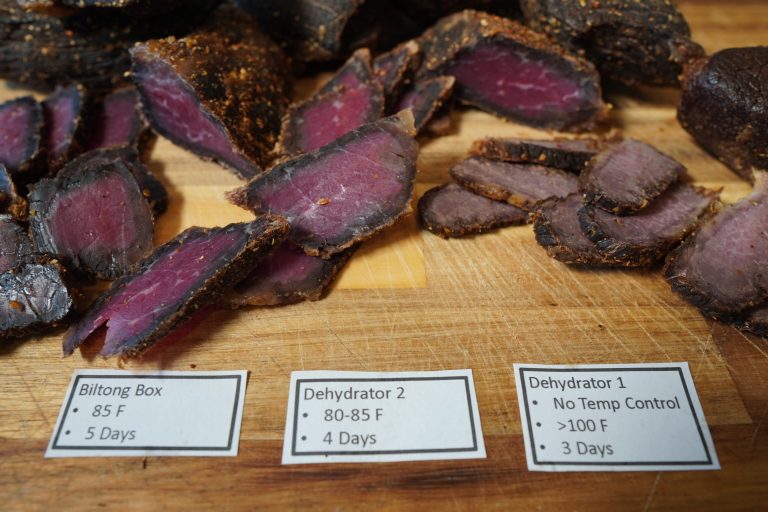In a power outage, instead of cooking and attracting attention, preserve your steaks as biltong, a scientifically proven, flavorful, and lasting protein source that protects against microbial threats and has a centuries-old history of enduring challenging conditions.
In this post, we’ll show you how to make emergency biltong. When the power goes out, and your refrigerator is warming by the second, having biltong ingredients and equipment on hand to preserve your meat is essential. This traditional dried, cured meat from Southern Africa is made by marinating beef or game meats in vinegar and spices and then air-drying it over several days. It’s a high-protein snack or emergency food you will be glad you know how to make. I’ll take you step-by-step through the traditional air-drying recipe and also try methods in two different dehydrators to compare the results. Stick around to the end, and I’ll show you how I made the special biltong box that I used here. You likely have everything you need to build it right now or after any disaster.

What You Need
You’ll need some basic equipment to process and dry the meat.
- A sharp knife & cutting board
- Mortar and pestle or device to grind down the spices
- Small pan for warming the spices.
- Bowl to marinate.
- Dehydrators or biltong box. (Remember, at the end I will show you how to build a Biltong box for mere pennies out of materials you may already have on hand).

Ingredients
- 4 pounds beef (sirloin, top, or bottom round are good cuts for this. Favor slices with long sections of grain flowing in a single direction)
- ¾ cup vinegar
- ¼ cup red wine vinegar (This is the blend that I use for just a hint of residual flavor. You can use any vinegar except balsamic.)
- 2 Tablespoons Worcestershire sauce
- 4 Tablespoons coarse salt (If using granulated salt, reduce to 3 Tablespoons. Recipes will vary wildly online along with complaints about being too salty. Minimally, use a half Tbsp per pound. I find that
- 1 Tablespoon of coarse salt (Coarse, Flake, Himalayan, or Sea Salt) per pound is best.)
- 2 Tablespoons coriander seeds
- 1 Tablespoons black peppercorns
- 1 Tablespoons brown sugar
Optional: chili flakes, fennel seeds (I use a teaspoon of each)

Prepare the Meat
Cut the Beef: Remove most of the fat and any gristle from the meat. Slice the beef into strips approximately 1 inch thick, 2 inches wide, and up to 8 inches long. You see here the grain and my meat ended up being two pieces. I thought it was one piece when I bought it. That means my Biltong can only be as long as the cutting with the grain will allow. Ideally you want it longer. I slice these pieces with the meat’s grain, so I can cut the finished dry product against the grain. That will provide me with less chewy, tender pieces. This specific cut ensures that the meat cures properly and has the desired texture and flavor.

Marinate the Meat
Immerse the meat in the ¾ cup vinegar, ¼ cup red wine vinegar, and 2 Tablespoons Worcestershire sauce in a large container or bowl. Mix by hand to ensure full coverage of the liquid. Cover and set aside. Marinate the meat strips in the mixture for 3 to 4 hours to begin the curing process.
After at least 4 hours have passed, remove the meat strips from the vinegar mixture, squeeze, and pat dry with paper towels to remove excess moisture. Reserve the vinegar mixture for later.

Season the Meat
Toast coriander seeds and any other spices in a dry pan, but not the peppercorns. This will only take a few minutes, and you should really start to smell them as they release their aroma. They may toast a bit. That’s fine, but don’t let them burn. This process awakens the oils in the spices. Place them in your spice grinder or mortar and pestle. Add in the peppercorns. Then, rough grind them, leaving some seed shells intact. Add the coarse salt and grind a little more. Then add the brown sugar. There’s no need to grind that in, just mix it with your hand.
Pull out 2 tablespoons of the dry spices for later use. Place the remaining spices thoroughly over the meat strips. Work it over the pieces with your hands, ensuring an even coating. I then place it all in a ziplock bag and mix it around from the outside. Let it rest for another 3 hours.

Rinse and Hang the Meat
Once that time has passed, rinse the spiced meat strips in the reserved vinegar mixture to remove excess spices. Then, I like to grind that reserved tablespoon of spices further and add it back to the meat. This gives it a nice seasoned crust. If you have longer strips, you would want to weigh them at this point because you are looking for a 50% reduction in weight for your finished process as it dries. Because my strips are so small from accurate grain cutting, I don’t need to weigh these. Run your wire through one end of each strip and hang them in your biltong box in a well-ventilated, isolated place for 5 to 10 days. I’ll also be placing them in two different dehydrators on their lowest settings so I can compare the results. With the biltong box, I am able to poke the wire through the top of the box and give it a few twists to create a sort of meat locker I can seal by closing up.
The main thing you want here is to avoid direct sunlight and have a good airflow. This is why I added the screen to the box, which I will show you how to do later. That will allow airflow through the sealed box and keep out any unwanted insects. After sealing the box, I placed all the drying devices in the garage and put a fan on a low setting at the lower vent of the biltong box to maintain a constant airflow.
The general time in a dehydrator to obtain the desired results is 24-36 hours. It will depend on the thickness of the meat and the fat content. You want the temperature to be between 70 and 80 degrees Fahrenheit to prevent the meat from drying too quickly. My garage is right in that perfect zone between 80 and 85 degrees during the Summer.
Check for Readiness
The biltong is ready when it has shrunk to half its original size, feels firm yet flexible when gently squeezed, and has attained a dark red or burgundy interior color. This slight flexibility indicates the ideal residual moisture level, ensuring the biltong is neither too dry nor too hard. Again, with longer strips, you can weigh it again when you think it is done. You want somewhere near a 50% reduction in weight.

Slicing & Storage
After completing the drying and aging process, slice the biltong into bite-sized pieces or strips when ready to eat. Cutting against the grain will give you shorter, more tender pieces while cutting with the grain will result in longer, chewier pieces. You’ll want to slice it as thin as you can with the sharpest knife you have. The dryer it is the more you may struggle. I can also see using a sandwich meat slicer to get incredibly thin slices for sandwiches. Slice only as you eat and consume it because slicing it will expose the center of the meat that had less exposure to the curing and preserving ingredients and will increase surface exposure to air. It’s best to store the biltong in its seasoned and dried whole form and slice only when you plan to consume it within a week.
I found the dehydrator without temperature control, over 100 degrees, and after 3 days, had a more jerky-like consistency and lacked the burgundy-colored interior. The dehydrator with a temperature control set between 80 and 85 degrees for 4 days was more like traditional Bitlong. The best was easily the Bitlong Box I will show you how to make in a moment. That was approximately 85 degrees for 5 days, but probably could have gone to 7 or 10 days for a dryer product. The taste is difficult to describe. It’s tender, with a light flavor from the spices. I could see adding maybe a little red wine to the marinade. It reminded me of a lightly cured meat like a Jamon, Prosciutto, or more accurately a Bresaola Punta D’Anca. If you’ve never had any of those, just think of it as a super mild salami, though that flavor note may have come more from the fennel I added then the coriander.
I could definitely see myself eating this as a good source of protein on any hike. It’s a lot less salty than traditional jerky tends to be. If you don’t eat it all immediately (and it tastes so good you might), store the whole, unsliced biltong in a cool, dry place. It can be frozen to last up to a year. It will last a week or longer when stored in a paper bag or jar. Pack it in salt for long-term storage to further dry it, inhibit bacterial growth, and extend its shelf life to several weeks or even months.

Biltong Box
To build the biltong box that I used in this video, you only need a box of some kind, the ability to cut holes in it, some wire, some screening material, and either some glue or duct tape. You can use a wooden box or plastic container if you want to build something sturdier. The goal is to allow the circulation of dry air while keeping out any flys or other bugs. I like using screens, so I simply cut about a ½” slit about 6-8 inches long on one side’s bottom.
I will repeat this cut on the opposite wall but a few inches down from the top. The precise cut of the whole is up to you. We’ll be covering it, so I don’t feel the need to measure here. Then, I can cover that whole from the inside with a piece of screening material and some duct tape around the edges. These wholes will facilitate circulation and keep any bugs out. If your environment isn’t warm enough, I have seen some people put a light bulb or heating source in the box to achieve the 70 to 80 degrees necessary. My garage in the summer is pushing the outer limits of that range, so I’ll just use a simple fan to push a gentle breeze through. I have also seen people hook up battery fans or small PC fans to achieve that gentle circulation of air from the bottom through to the top. Your circumstances, temperature, and humidity will have to guide you on the best practice for your situation, but remember that this technique of making biltong is centuries old. That’s long before electricity and only requires you to have a bug-free environment and circulating dry air.
To hang the meat, I simply run a wire through one end, poke both ends of that wire through the top of the box with the open flaps facing me, and twist it at the top to secure it. I hang each piece so they’re not touching, then close the flaps, seal it with some tape, and come back in about five to seven days to take a look and test the doneness. It couldn’t be simpler.
As always, stay safe out there.






